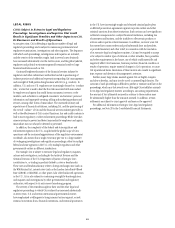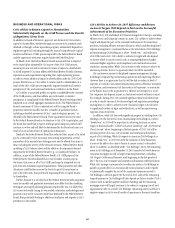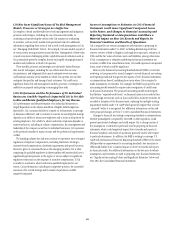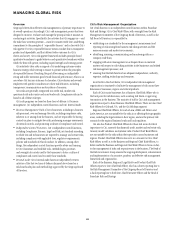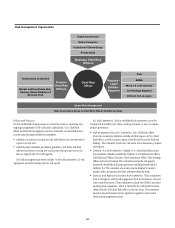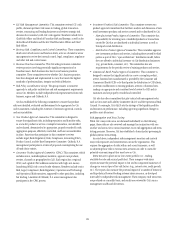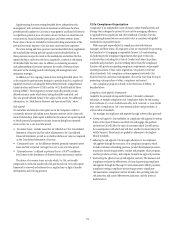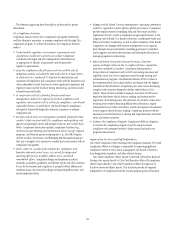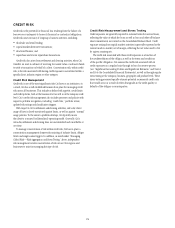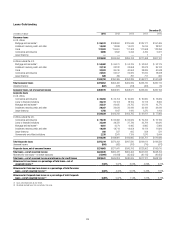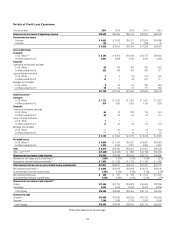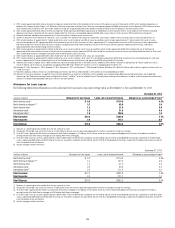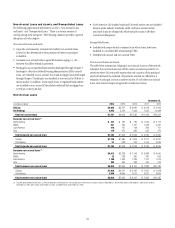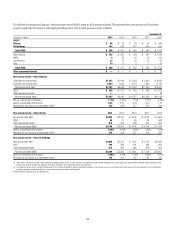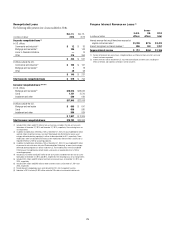Citibank 2014 Annual Report Download - page 87
Download and view the complete annual report
Please find page 87 of the 2014 Citibank annual report below. You can navigate through the pages in the report by either clicking on the pages listed below, or by using the keyword search tool below to find specific information within the annual report.70
• ICG Risk Management Committee: This committee reviews ICG’s risk
profile, discusses pertinent risk issues in trading, global transaction
services, structuring and lending businesses and reviews strategic risk
decisions for consistency with Citi’s risk appetite. Members include Citi’s
Chief Risk Officer and Head of Franchise Risk and Strategy, as well as the
Global Head of Markets and the ICG Chief Executive Officer and Chief
Risk Officer.
• Business Risk, Compliance and Control Committees: These committees,
which exist at both sector and function levels, serve as a forum for senior
management to review key internal control, legal, compliance, regulatory
and other risk and control issues.
• Business Practices Committee: This Citi-wide governance committee
reviews practices involving potentially significant reputational or
franchise issues. Each business also has its own business practices
committee. These committees review whether Citi’s business practices
have been designed and implemented in a way that meets the highest
standards of professionalism, integrity and ethical behavior.
• Risk Policy Coordination Group: This group ensures a consistent
approach to risk policy architecture and risk management requirements
across Citi. Members include independent risk representatives from each
business, region and Citibank, N.A.
Citi has established the following committees to ensure that product
risks are identified, evaluated and determined to be appropriate for Citi
and its customers, including the existence of necessary approvals, controls
and accountabilities:
• New Product Approval Committee: This committee is designed to
ensure that significant risks, including reputation and franchise risks,
in a new ICG product or service or complex transaction, are identified
and evaluated, determined to be appropriate, properly recorded for risk
aggregation purposes, effectively controlled, and have accountabilities
in place. Functions that participate in this committee’s reviews
include Legal, Bank Regulatory, Risk, Compliance, Accounting Policy,
Product Control, and the Basel Interpretive Committee. Citibank, N.A.
management participates in reviews of proposals contemplating the use
of bank chain entities.
• Consumer Product Approval Committee (CPAC): This committee, which
includes senior, multidisciplinary members, approves new products,
services, channels or geographies for GCB. Each region has a regional
CPAC, and a global CPAC addresses initiatives with high anti-money-
laundering (AML) risk or cross-border elements. Members include senior
Risk, Legal, Compliance, Bank Regulatory, Operations and Technology
and Operational Risk executives, supported by other specialists, including
fair lending. A member of Citibank, N.A. senior management also
participates in the CPAC process.
• Investment Products Risk Committee: This committee oversees two
product approval committees that facilitate analysis and discussion of new
retail investment products and services created and/or distributed by Citi.
- Manufacturing Product Approval Committee: This committee has
responsibility for reviewing new or modified products or transactions
created by Citi that are distributed to individual investors as well as
third-party retail distributors.
- Distribution Product Approval Committee: This committee approves
new investment products and services, including those created by third
parties as part of Citi’s “open architecture” distribution model, before
they are offered to individual investors via Citi distribution businesses
(e.g., private bank, consumer, etc.). This committee also sets
requirements for the periodic review of existing products and services.
• Commercial Bank Product Approval Committee: This committee is
designed to ensure that significant risks in a new or complex product,
service, business line manufactured or provided by the Consumer and
Commercial Bank (CCB) or by third parties for distribution to CCB clients,
or certain modifications to existing products, services or business lines,
undergo an appropriate and consistent level of review for CCB and its
customers and are properly recorded and controlled.
Citi also has other committees that play critical risk management roles,
such as Citi’s Asset and Liability Committee (ALCO) and the Operational Risk
Council. For example, Citi’s ALCO sets the strategy of the liquidity portfolio
and monitors its performance, including approving significant changes to
portfolio asset allocations.
Risk Aggregation and Stress Testing
While Citi’s major risk areas are discussed individually on the following
pages, these risks are also reviewed and managed in conjunction with one
another and across Citi’s various businesses via its risk aggregation and stress
testing processes. Moreover, Citi has established a formal policy governing its
global systemic stress testing.
As noted above, independent risk management monitors and controls
major risk exposures and concentrations across the organization. This
requires the aggregation of risks, within and across businesses, as well
as subjecting those risks to various stress scenarios in order to assess the
potential economic impact they may have on Citi.
Stress tests are in place across Citi’s entire portfolio (i.e., trading,
available-for-sale and accrual portfolios). These company-wide stress
reports measure the potential impact to Citi and its component businesses of
changes in various types of key risk factors (e.g., interest rates, credit spreads,
etc.). The reports also measure the potential impact of a number of historical
and hypothetical forward-looking systemic stress scenarios, as developed
internally by independent risk management. These company-wide stress tests
are produced on a monthly basis, and results are reviewed by Citi’s senior
management and Board of Directors.



